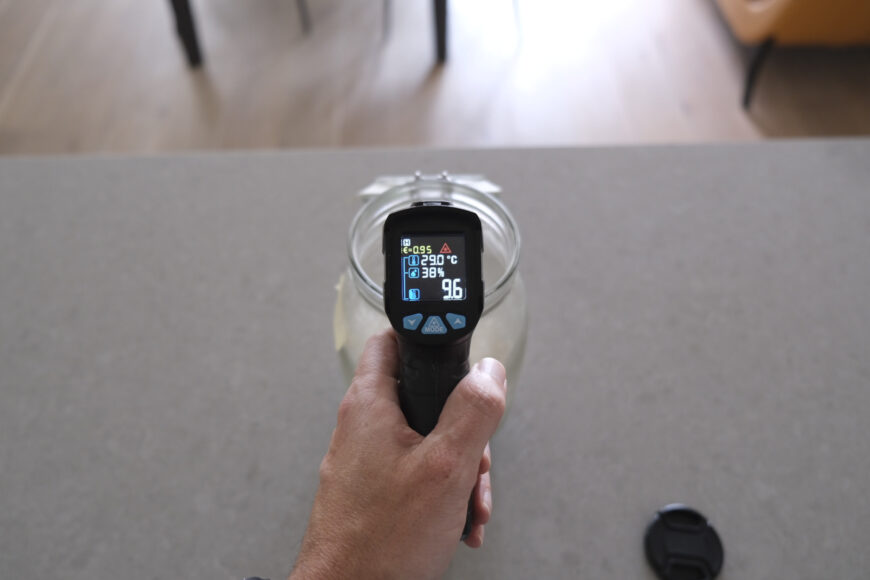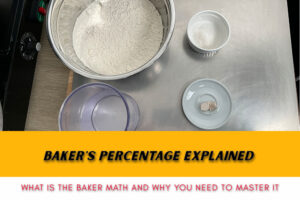
Perfect pizza dough kneading: the dough temperature
Last updated on May 19th, 2023 at 10:11 pm
The content of this blog post will help a lot especially when kneading during summer and using a home mixer. In fact I am going to share some tips around the best pizza dough temperatures. We are going to talk about a very underestimated topic when making pizza at home. Be honest: do you know that temperatures are playing a key role in the pizza dough preparation? Especially if you do not have professional equipment this topic will improve a lot your pizza dough making. Particularly during summer when it becomes complicated to knead because of warm temperatures at home. If you are kneading by hands then you only need a few tricks. But when it comes to home mixers the game is changing!
Therefore I think it is important to share my experience and give you advise to improve your pizza dough during all seasons but especially in summer.
-
Ideal Pizza Dough temperatures
It’s not a secret for experienced home pizzaiolo that you want to reach your final stage of kneading the pizza dough within certain temperatures range. The reason behind that is first of all related to the role of temperature on the yeast. I am not going into details, no reason for that. Essentially we need to facilitate yeast action avoiding to slow or accelerate too much the fermentation/dough rising. Moreover if we have the dough at too high temperatures other chemical processes will start. In the worst case you will have to throw ingredients as they will become a sort o Ghostbusters slimer 😀
As you easily understand there is an ideal temperature you want to have when you “close” the dough. We define “dough closure” the moment when, after kneading, the gluten mesh is created and strong enough for what we want to do. The ideal temperature is within a range and can change depending on the hydration of the dough:
| Hydration | Ideal Temperature |
| Up to 54% | 22/23 °C (72/74 °F) |
| 55% to 64% | 23 °C (74 °F) |
| 65% to 85% and more | 23/25 °C (74/77 °F) |
Obviously you will not fail your Pizza if you go a bit over even though it is better to do your best to stay within the suggested ranges. When using home mixers I personally find no issues to reach even 26/27 °C (77/80 °F) in case of high hydration dough. In such case you can reduce the amount of time the dough will rest before the “Puntata“. If you don’t know what “Puntata” is I recommend you to read this article.
Now that we know more about temperatures, let’s understand how we can influence them.
-
How to close pizza dough at right temperature (with formula to calculate ingredients temperature)
In normal conditions we have a few temperatures we have to deal with. You can influence some but not all of them:
-
- Flour Temperature (F.T.)
- Water Temperature (W.T.)
- Room Temperature (R.T.)
- Temperature coming from the mechanical forces applied by the stand mixer (M.T.)
Generally we store flour at room temperature. We assume in this case that the flour temperature (F.T.) is 1 °C lower than the room temperature (R.T.). If we have particular conditions and we store the Flour in fridge or in a cellar then it’s best to use a food thermometer (more details here) without working on assumptions.
The temperature that is coming from the forces applied from the mixers is unpredictable. Professional mixers will cause an increase of temperature of few degrees but stand mixers we use at home are a different story. In my experience the temperature can easily grow by a degree every 15/30 seconds of mixing!!
You can easily get that the ingredient we can use to manipulate temperatures and reach the “dough closure” at the temperature we want is the water. But how to calculate how cold the water should be for our purpose? Well, there is a well-known formula you can apply:
(Desired Final dough temperature x 3) - (F.T. + R.T. + M.T.)
Let’s make an example where we want to close the dough at 23 °C:
| Desired Final Dough Temp. | 23 °C |
|---|---|
| Flour Temp. (F.T.) | 21 °C |
| Room Temp. (R.T.) | 22 °C |
| Mixer temperature (M.T. | 14 °C |
| Water Temperature to use (23x3) - (21-22-14) | 6 °C |
With that said you now know what you need to help you making the Pizza dough like a professional Pizzaiolo. But wait, we still miss what I promised before: my best pizza dough temperatures tips! So let’s start!
-
Water in freezer, during summer is a must!
Surely you can use the formula I shared above to calculate ideal water temperature. However there is a variable that is very hard to get: temperature generated by home stand mixers. How do I deal with that?
Well, I know perfectly my stand mixer and over time I tested how much temperature it adds every 20 seconds of kneading at different speeds. So I can approximately calculate how much time I expect to knead a particular Pizza and apply the variable to the formula.
If you don’t wan’t to go that deep then you have only one option: use the freezer. My recommendation is to take the amount of water that you need to you use in your recipe, add it in a plastic container and put it in the freezer. Depending on the amount of water it can take between 2 to 5 hours to reach the right very low temperature. Specifically you want to find water that just started to become ice. Ideally it has a first layer of 1 mm of ice on top.
Don’t forget to prepare your almost-frozen water in advance, especially during summer!
-
Best pizza dough temperatures tips? Get Infrared Pyrometer (or food thermometer)
I always considered that measuring temperatures when dealing with dough is a great step to improve your skills. This is even more true when it comes to kneading italian pizza dough. I always have my pyrometer at handy and I constantly measure temperatures. I can totally assure you that is a game changer in your kitchen, not only for pizza!
It’s a very cheap instrument so go for it and start measuring temperature of ingredients and of your dough!
-
Flour in fridge and Stop&Go technique
As a conclusion to this journey around dough temperature I want to share two more tips. They are especially valid if you do not have a way to measure the temperature of your dough or in case you struggle in keeping it under control.
First of all, when is very warm, move the flour in fridge for few hours before kneading. I prefer to only do that with amount of flour I am going to use, not with all I have in the container. I prefer not to have the flour changing temperatures too often as it creates a good environment for the mold to grow.
Secondly you can use the Stop&Go technique. It consists in stopping your kneading machine for 10 or more minutes after you reach a temperature that is too high yet the dough is not ready. If the room temperature is higher or very close to the ideal one for the dough you can move the mixer bowl in the fridge during the break. Just be careful to cover with a lid or cling film your bowl to avoid that the dough becomes dry.
And this concludes my best pizza dough temperatures tips post. I hope you enjoyed it.
If you have doubts or questions you can always contact me. Also leave me a comment and share it on social media!
If you like my content subscribe to the newsletter to be notified about upcoming pizza secrets sharing:




3 Comments